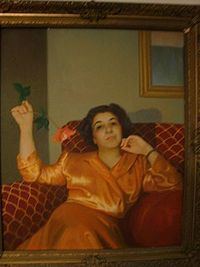Nationality Peruvian Spouse(s) Jose Anduaga Ethnicity Hispanic Name Clotilde Arias | Citizenship Peruvian Role Lyricist Occupation Composer, performer Died 1959 | |
 | ||
Known for Composition of song "Huiracocha" and official translation of U.S. anthem to Spanish | ||
Luigi alva huiracocha clotilde arias
Clotilde Arias Chávarri Anduaga de Ferrero (20 June 1901 – 6 May 1959) was a Peruvian-American lyricist and composer.
Contents
She is best known for her composition of the song "Huiracocha", popular in Peru and sung worldwide; and for her translation of the "The Star-Spangled Banner", the United States national anthem, into lyrical Spanish, commissioned by the U.S. Department of State in 1946.
Himno ee uu en espanol por clotilde arias
Life
Arias was born in 1901 in Iquitos, Perú, on the shores of the Amazon. She moved to New York City in 1923 to study music. She married José Anduaga, another Peruvian artist, in 1929. They settled in Brooklyn and had a son, Roger. By the early 1940s, Arias had divorced Anduaga and moved to Manhattan with her son. In 1942, she became a naturalized U.S. citizen.
Arias's artistic talents in music, painting, and composing – including playing for silent movies – emerged early in Iquitos. She achieved scholastic and artistic recognition, with numerous honors. Her perfect pitch and exceptional ability to sight read made her a highly sought accompanist.
Amongst her numerous compositions, "Huiracocha" may be the best known. Named for a god of the Incas, the song retells the legend of his emergence from the depths of Lake Titicaca to create the sun, moon, and stars, and to breathe life into Allcavica, ancestor of the Inca people. According to Arias's own program note, this song is "dedicated to the Indian, the Forgotten Man of the Americas". It tells of the "sadness of a race calling to the ancient god of their forefathers, who no longer hears his children".
Throughout the 1930s and 1940s, Arias gained success as a composer in the male-dominated advertising industry. She worked for advertising agencies and composed jingles for Alkaseltzer, the Ford Motor Company and the Campbell Soup Company.
Arias composed other serious classical songs, including "Idilio Roto (Broken Idyll)," as well as songs in the popular style of the 1930s, some of which she sold door to door to help support her family. Later, she collaborated with notable composers and writers, including Marjorie Harper, Andy Razaf, Albert Gamse and Irving Caesar. Best known were her Spanish lyrics to song hits "Rum and Coca-Cola" (English lyrics by Morey Amsterdam) and "Managua Nicaragua" (English lyrics by Albert Gamse).
Tributes
On December 9, 2006, "Huiracocha" was performed at London's Barbican Hall by tenor Juan Diego Flórez. A separate 2009 performance of Huiracocha on YouTube is also available for viewing.
In 2013, "Huiracocha" was recorded by Ward De Vleeschhouwer on the album Chicha Morada in a version for piano solo.
Her lyrical Spanish translation of "The Star-Spangled Banner" is on display in The Star-Spangled Banner exhibit at the National Museum of American History in Washington, D.C. (See article on Smithsonian Magazine)
An exhibit with a display of her cultural achievements in the arts and writings opened at the Albert H. Small Documents Gallery September 27, 2012, and was on display until April 2013.
